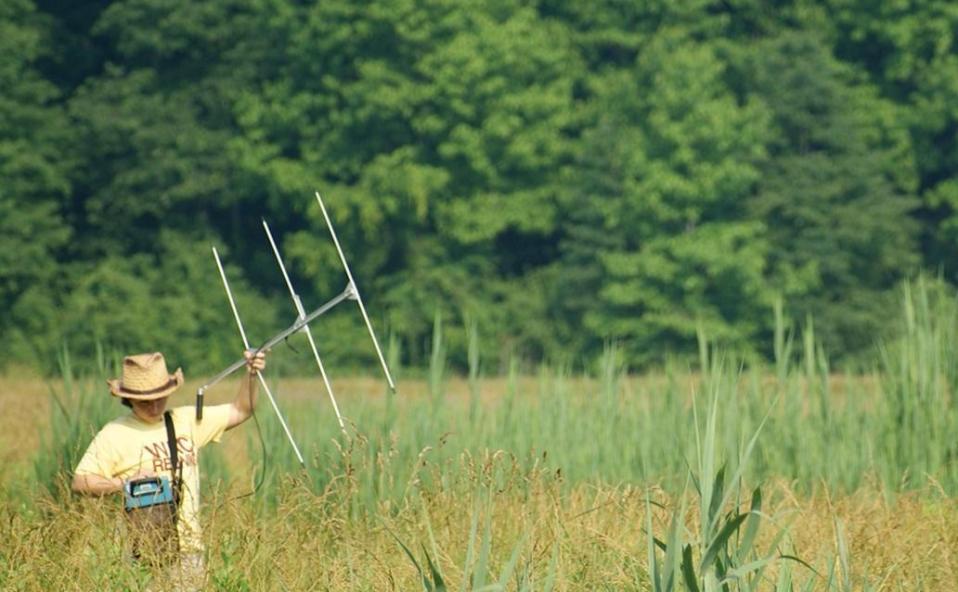After Hannah O’Malley proposed that her senior thesis be based on research with Washington College Biology Associate Professor Aaron Krochmal, the results of her original hypothesis and the pair’s collaboration to test it are helping conservation managers reassess the role of learning when it comes to moving endangered animals from one habitat to another.
The results of their study are featured in a manuscript entitled “An Empirical Test of the Role of Learning in Translocation” published this summer in the online edition of Animal Conservation. Coauthored by Krochmal’s research associate Timothy C. Roth of Franklin & Marshall College, the paper will be the print edition’s cover story in February 2018.

Hannah O’Malley ’12 in the field radio-tracking Eastern painted turtles.
For O’Malley ’12, a biology major who minored in secondary education and has gone on to become a key member of Walt Disney’s Animals Sciences and Environment education team, co-authorship of her first peer-reviewed paper “feels great, and I’m very excited to officially see it in writing, (and) that my thesis has a purpose beyond just being my Senior Capstone Experience. I love that it has implications for conserving species.”
Although many researchers have studied translocation—the practice of moving an animal from one location to another to protect it from habitat loss or other extinction risks—this research is the first that examines the practice experientially through the lens of cognition and learning. Wildlife managers have long used “soft release”—giving an animal time to learn a new habitat by penning or otherwise protecting it for a period of time before turning it loose—but this research shows that for some species, even soft-release translocation can only succeed if the animals are able to learn the new habitat.
For Eastern painted turtles, whose migratory patterns and navigational methods Krochmal and his students have been studying for eight years, that critical window of learning only happens within their first three years of life. O’Malley was one of Krochmal’s Summer Research students who had worked with him on turtle research at DuPont’s Chesapeake Farms, a 3,300-acre agriculture and wildlife management property near the College.

An Eastern painted turtle with radio tag attached sets off in search of a new water source.
“This project was Hannah’s idea. She was looking into the conservation education side of things but with a strong science background,” Krochmal says. “She suggested the idea of translocating animals with both a short time window and a long time window to compare their behavior against animals that live in that habitat, asking ‘Can you, as newly introduced animal, catch up to their culture?’ And the answer is no, unless you do it when you’re young.”
These data, Krochmal says, encourage more research into this question for other species that are likely to need translocation. And, it can help conservation managers better allocate limited resources—for instance, they may want to spend their money and efforts only on juvenile and newly hatched turtles, rather than adults, since the former are clearly able to learn a new environment while the latter will likely die in the attempt.
“I remember Dr. K saying, ‘What do you think is going to happen?’ and I said, ‘We’re going to translocate turtles and they’re not going to know what the heck is going on,’ ” says O’Malley. “I had already watched how the resident turtles know so clearly what they’re doing. It’s like us waking up in the morning and saying, ‘It’s wintertime and I guess I need to put my coat on.’ They just know what to do.”
Asking newly introduced adult turtles to learn the new habitat “was like moving someone from Florida up north—‘Whoa! I don’t know how to handle this!’ It would have been cool if they miraculously have this sense of direction without having to learn that, but we definitely saw that was not the case.”
In her career with Disney, O’Malley works with other teams to connect children and families to the global environment, creating outdoor education experiences at Walt Disney World in Florida, as well as curricula and resources for educators. For instance, while working with content from the film “Moana,” O’Malley helped develop an activity packet and teacher resource guide that included lessons on sea turtle conservation, while with the new film “Born in China,” she worked on materials related to education and conservation of pandas, snow leopards, and golden snub nosed monkeys—key species featured in the film.
Her work with Krochmal, she says, taught her that the purpose of research is less to find answers than to learn what are the next questions to ask. As an educator now, she also has realized fully the value of his method of mentorship.
“Dr. Krochmal was one of the first educators who treated me as an equal,” she says. “It was, ‘OK, we have this question, let’s work on it together and see where it goes and where it takes us.’ He would say, ‘This is as much your project as it is my project.’ Over time I became more and more invested and empowered and more confident, and I definitely felt like I was contributing, which as a student you don’t always get.”
See the Animal Conservation abstract here: https://onlinelibrary.wiley.com/journal/10.1111/(ISSN)1469-1795/earlyview
Read the entire paper: here: https://www.researchgate.net/publication/317719204_An_empirical_test_of_the_role_of_learning_in_translocation
Learn more about the turtle research here: https://www.facebook.com/taskforceturtle1/
About Washington College
Founded in 1782, Washington College is the tenth oldest college in the nation and the first chartered under the new Republic. It enrolls approximately 1,450 undergraduates from more than 35 states and a dozen nations. With an emphasis on hands-on, experiential learning in the arts and sciences, and more than 40 multidisciplinary areas of study, the College is home to nationally recognized academic centers in the environment, history, and writing. Learn more at washcoll.edu.



Write a Letter to the Editor on this Article
We encourage readers to offer their point of view on this article by submitting the following form. Editing is sometimes necessary and is done at the discretion of the editorial staff.